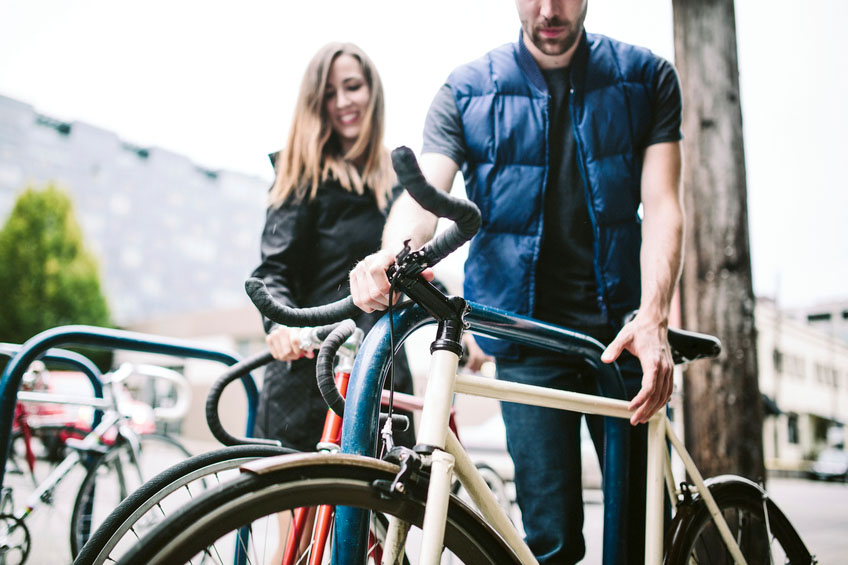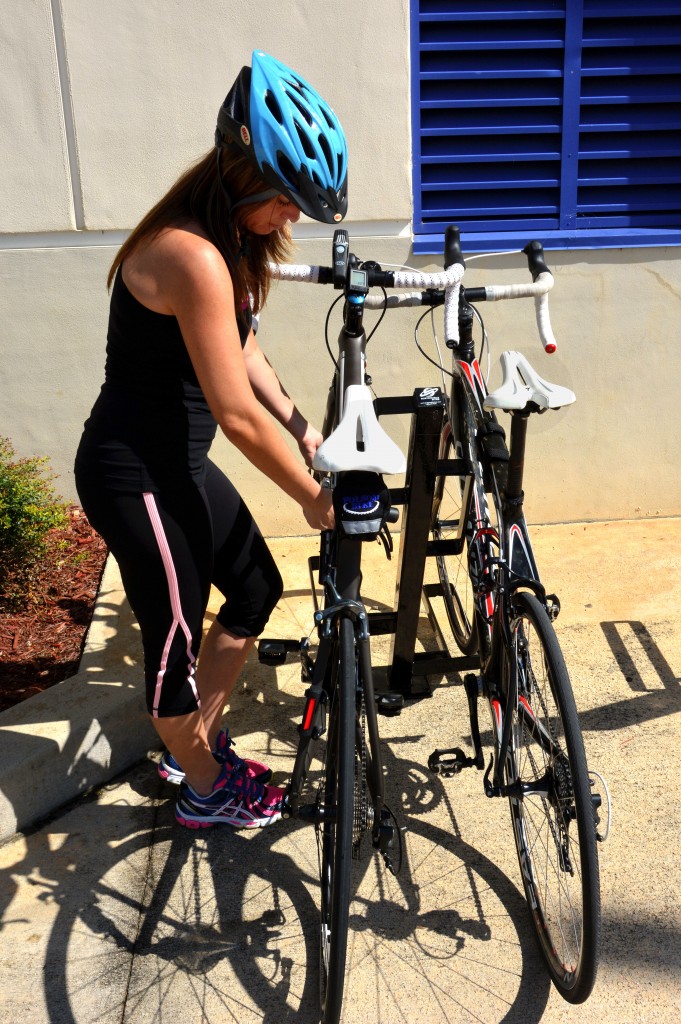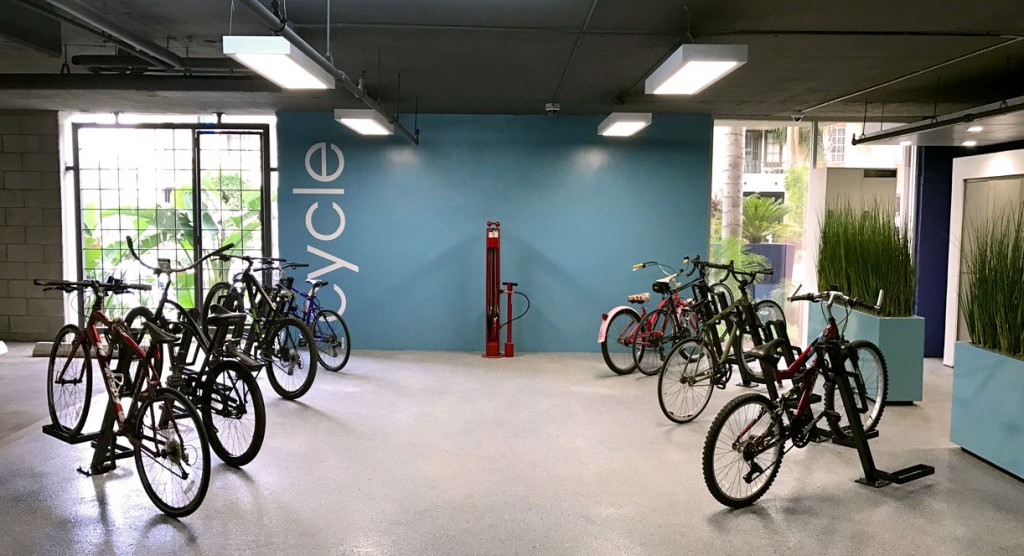 A couple lock their bikes to commercial bike racks near a facility. Developers can earn LEED credits for adding bicycle parking racks to their apartment or office buildings
A couple lock their bikes to commercial bike racks near a facility. Developers can earn LEED credits for adding bicycle parking racks to their apartment or office buildings
Did you know that you can earn LEED credits for providing commercial bike racks at your facility?
LEED is a highly recognized third-party verification program for green buildingsâ€â€Âit stands for Leadership in Energy and Environmental Design. Its innovations are changing the way people think about planning and constructing buildings. According to the U.S. Green Building Council, an incredible 1.85 million square feet of space is certified daily.
Property managers, homeowners, CEOs of businesses, and all kinds of people are interested in earning LEED credits with a goal of adding the credits up to a certification level: either Certified, Silver, Gold, or Platinum. LEED Certification at any level translates into great things for a business.
How Credits from Commercial Bike Racks Helps Your Business
1. Become more eco-friendly. While it seems obvious, there's no denying that following LEED standards will reduce your carbon footprint and help protect the environment.
The Environmental Protection Agency estimates that 30% of greenhouse gas emissions are from electricity, followed by 26% in transportation and 21% in industry.
Adding green features to your building can reduce its impact on each of these categories. For instance, if employees, customers, or residents can easily ride their bicycle to your facility and use a bike parking rack, that's fewer cars on the road, reducing the amount of emissions due to transportation.
2. Use your LEED certification in marketing. Many customers specifically choose green buildings because of their eco-friendly mindset.
 Bicycle parking at certain facilities can be difficult due to lack of space. There are high-density bike racks that have a smaller footprint than traditional bike racks
Bicycle parking at certain facilities can be difficult due to lack of space. There are high-density bike racks that have a smaller footprint than traditional bike racks
No matter what kind of facility you run, LEED certification is a powerful accomplishment that will resonate with your customers. These people will view you as more than just "green"â€â€Âthey will also know that you are advanced and forward-thinking compared to competitors who do not have LEED certification.
Even if you don't technically qualify for LEED certification yet, following some of its guidelines and promoting green practices can still be marketable with customers.
3. Follow trends to stay modern. Consumer trends are going towards green options. The younger crowd especially cares about the environment.
A growing portion of Generation Z (the rising generation that is currently 15-20 years old) will pay more for products and services that are committed to social change and environmental impact.
In 2014, 55% would pay more for green services, but that rose to 72% in 2015. If the younger generations will pay more for buildings that are green, you can bet that catering to their preferences will benefit your business for the next 10 to 20 years.
4. Earn credits from federal or state taxes. Use the online Database of State Incentives for Renewables & Energy to discover federal or local tax incentives for making your building LEED compatible.
The incentives can come as personal or corporate tax credits; bond, rebate, grant, or loan programs; or tax exemptions. They can help offset the cost of making your facility up to LEED standards, or reduce the taxes you pay each year.
5. Save money on monthly energy bills. By installing energy-saving products at your facility, the investment can pay for itself after a few years, and then begin making you money.
Solar roof company Solar World estimates that commercial solar roofing in North Carolina would have a net cost of $3,402 after tax incentives.
The estimated utility savings over 25 years could be $223,321. Clearly, the savings add up quickly.
Bicycle parking can also save you money because you can fit more bicycles than cars in your parking area, which means less square footage used for parking. You can also charge a monthly fee for access to bicycle lockers or a bike room, which will help you earn revenue from the parking area.
6. Improve the resale value of your facility. For all of the above reasons, LEED certification is highly desired by customers and property owners.
If you ever decide to sell your facility, it may sell at a higher price than a traditionally constructed building. Buyers will know they are investing in a building that will have low monthly bills and will likely not need updating since it's already ahead of its time.
Requirements for Earning Credits for Bicycle Racks
Now that you understand the reasons behind updating your facility to LEED standards, you may be wondering how to qualify with bicycle parking. To earn LEED credits for bicycle parking, there are a few options for qualification.
"LEED credits are such an important consideration today in the construction industry," said Michael Kilmartin, Senior Relationship Manager at The Park and Facilities Catalog. "Adding bicycle racks, bike lockers or bike rooms is one of the simplest ways to earn those credits."
These apply to 90% of all new buildingsâ€â€Âany buildings without bicycle storage cannot exceed 10% of the total project.
- Bike rooms. These are considered long-term, indoor bicycle parking facilities because they are designed for more than just a few hours. It needs to be within 100 feet walking distance of any functional entry and easily accessible by all building users. The minimum number of long-term spaces is in addition to the requirements for short-term bicycle parking.
- Shower facilities. These are also required if you want to qualify your bike room or long-term parking for LEED points (except for residential properties, which do not require showers since guests can go home and shower). Showers need to be onsite, but health club access does qualify, as long as the visitor doesn't need to go outdoors.
- Bicycle Racks. Called "short-term bicycle storage" in the LEED documentation, this parking needs to be within 100 feet walking distance of any main entrance.
The amount of bicycle parking required depends on the type of facilityâ€â€Âretail must have at least two short-term bicycle storage spaces per 5,000 square feet (with a minimum of two), while mult-iunit residential buildings need storage for 2.5% of peak visitors (with a minimum of four). On-site showers and changing facilities need to be for the first 100 regular building occupants and one additional shower per 150 occupants afterwards.
Bicycle parking also needs to be no more than three miles from a bikable location, like a school, employment center, or public transit. Alternatively, they can also be within three miles of a bicycle network that extends at least three continuous miles and connects to a location like a school or employer.
If you follow the guidelines carefully, you can earn 2 LEED points; 40-49 are required for the lowest level of Certified. These points will get you started on your path towards earning LEED certification and improving your facility for years to come.
While going green might involve extra costs initially, one of the least expensive strategies you can follow to be sustainable-oriented is to add a bike room or commercial bike racks for buildings or apartments. It's a huge benefit for the public who use the facility, it's great for the owner of the building, and it's another way to protect the environment, one step (or pedal) at a time.
Note: Visit this page for more information on how to design a successful bike room.



